Struggling to decide if 3 sets are enough? Worried that 4 sets may be too much? Then this is the post for you! Because today, I’ll be discussing if 3 or 4 sets are better for building muscle.
3 and 4 sets can both build muscle. Generally speaking, 3 sets are ideal for hypertrophy and for higher training frequencies. In contrast, 4 sets are generally more suited to lower training frequencies and for balanced hypertrophy and strength gains.
I too struggled with this dilemma of choosing between 3 and 4 sets when I first started training.
I didn’t want to undertrain, nor did I want to overtrain!
So which is best?!
Allow me to share my research and experience.
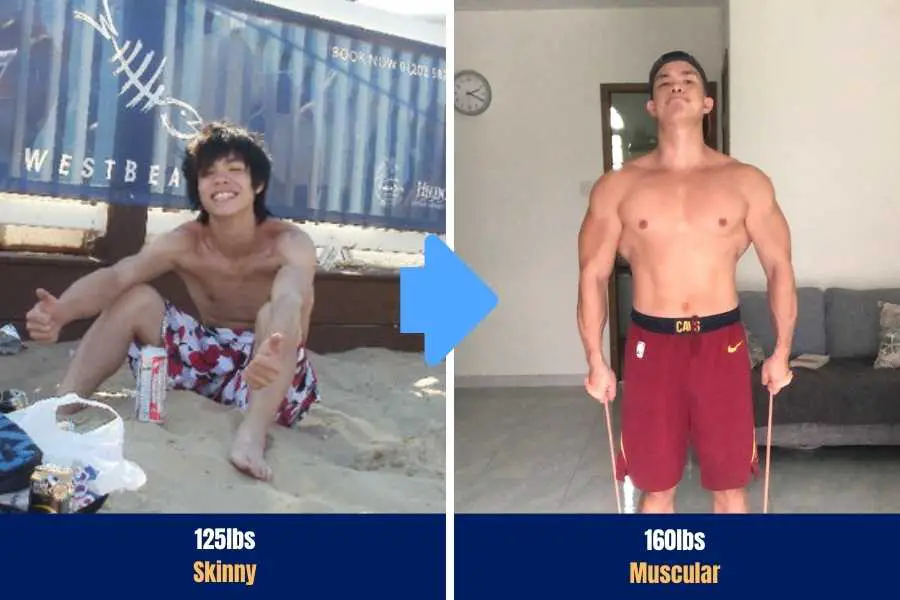
- Choosing Between 3 Or 4 Sets: Key Points
- Main Differences Between Doing 3 Vs 4 Sets
- Are 3 Or 4 Sets Better To Build Muscle?
- What Is Hypertrophy?
- Training Volume Drives Muscular Hypertrophy.
- Hypertrophy Follows A Dose-Response Pattern.
- Why 3 Sets Are Enough For Hypertrophy.
- How 4 Sets Can Also Be Ideal For Hypertrophy.
- Take Home Message: Work Within 3 And 4 Sets.
- Choosing The Optimal Number Of Sets.
- Are 4 Sets Too Much?
- Choosing The Right Number Of Reps.
- Set-Rep Combinations And What They Are Good For.
- Conclusion
Choosing Between 3 Or 4 Sets: Key Points
Here’s a summary of the key points when deciding whether to do 3 vs 4 sets to build muscle:
- Both 3 and 4 sets per muscle group per workout can build muscle.
- Doing 3 sets are ideal for lifting in a higher rep range (~15 reps) using lighter weights to promote hypertrophy.
- 3 sets can also be great for beginners who have just started training.
- Doing 4 sets are ideal for more experienced lifters to make optimal strength and size gains by lifting in a moderate rep range (8-12 reps) using heavier weights.
- 4 sets can also be great for intermediates who need to increase their training volume.
- 10-20 total weekly sets per muscle group are recommended for optimal muscle hypertrophy.
- Therefore choosing to do 3 or 4 sets in a workout is dictated by how many days you train per week. Fewer training days require more sets to be completed, while more training days allow you to do fewer sets.
Main Differences Between Doing 3 Vs 4 Sets
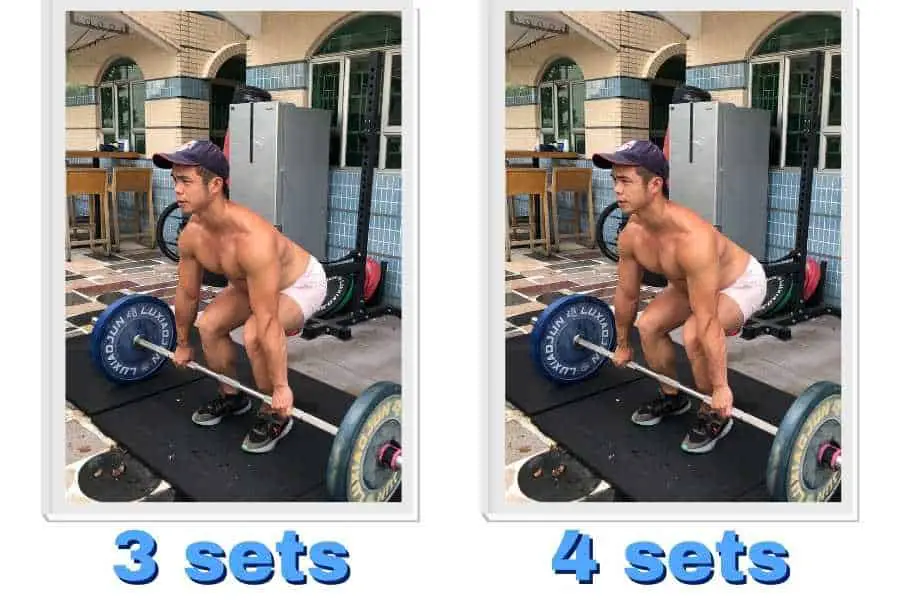
Let’s briefly start with the basics- what is meant by 3 vs 4 sets?
When comparing the differences, most people do so in terms of a given exercise per workout. In other words, should you be doing 3 lots of consecutive repetitions for an exercise before taking a break, or 4?
Both 3 and 4 sets can promote hypertrophy and build muscle. But there are slight differences in application and results, as follows:
| 3 Sets Per Workout | 4 Sets Per Workout | |
|---|---|---|
| Difference: | Lower training volume | Higher training volume |
| Recommended Rep Range: | 15+ reps per set | 8-12 reps per set |
| Ideal For: | Hypertrophy | Hypertrophy & strength |
3 sets per exercise per workout:
Since you’re doing one set less, compared to doing 4 sets, your total training volume is naturally reduced.
This makes 3-set training ideal for exercises performed at higher rep ranges and lighter weights (for example, 15 reps per set) where the increased number of repetitions make up for the reduced number of sets.
It’s great for getting a good muscle pump on a time-limited workout, but generally not ideal for strength gains.
It can also be suitable for beginners who have just started working out.
4 sets per exercise per workout:
The extra set completed, compared to doing 3 sets, means your total training volume is naturally increased.
4-set training is therefore great for exercises performed at low-moderate rep ranges (for example, 8-12 reps per set) which allow you to lift heavier weights.
4 sets of 8-12 reps are generally considered by most to be ideal for making balanced muscle size and strength gains. But this style of training usually leads to longer workouts.
Are 3 Or 4 Sets Better To Build Muscle?
A commonly asked question- are 3 or 4 sets better for hypertrophy and building muscle? The truth is they are both equally effective, and most people overthink the details.
Next, I will now explain why 3 and 4 sets can be equally effective at inducing muscle hypertrophy (growth).
First, you should know the mechanisms behind muscle growth.
What Is Hypertrophy?
Muscular hypertrophy is the process by which your muscles grow larger.
Hypertrophy is driven by resistance training, which breaks down your muscle fibers and these are subsequently repaired.
When resistance training occurs regularly, your muscle fibers are repeatedly broken down and rebuilt. And this causes the fibers to become larger and more numerous.
When this process is repeated, and combined with a good diet plan, you will see signs of muscle growth.

Furthermore, there are two types of hypertrophy:
- Myofibrillar hypertrophy- the myofibrils (contractile components of muscle) increase to make the muscle stronger and larger.
- Sarcoplasmic hypertrophy- the sarcoplasm (energy-providing fluid surrounding muscle cells) increase to make the muscle larger but not necessarily much stronger.
As you will see later, 3 and 4 sets are both able to drive myofibrillar and sarcoplasmic hypertrophy.
Training Volume Drives Muscular Hypertrophy.
Hypertrophy requires you to resistance train on a regular basis with a sufficient amount of volume. Without enough volume, your muscles simply won’t receive adequate signals to start growing.
For this to happen, you need to follow an effective training program.
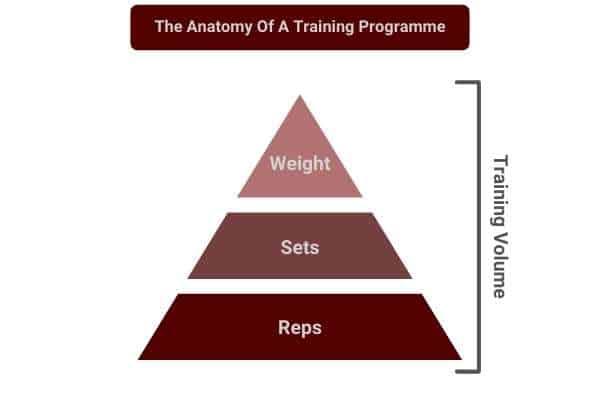
The fundamental components of a training program are:
- Reps (repetitions)- are the single movement for an exercise, usually composed of an upward and downward phase. An example is squatting a barbell up and lowering it down again for one repetition.
- Sets- a group of reps performed without a break. The moment you begin to rest, you have completed a set.
- Weight- is how much weight you are lifting for each repetition. It’s also referred to as exercise intensity because a heavier weight usually requires a higher contractile intensity from your muscle.
- Training days- are the number of workouts you perform for a given muscle in a week.
Together, these components make up your total training volume (reps x sets x weight x training days). It’s a way to define the total amount of work you perform in a week.
When comparing 3 and 4 sets, and asking which is better, you need to understand that both can produce the same training volume (I’ll explain in detail below).
As such, 3 sets can be just as effective as 4 sets. And 4 sets can be just as good as 3 sets.
Hypertrophy Follows A Dose-Response Pattern.
Hypertrophy is dose-responsive.
In other words- the more work you put in, the more your muscles will grow….up to a point.
Let me explain.
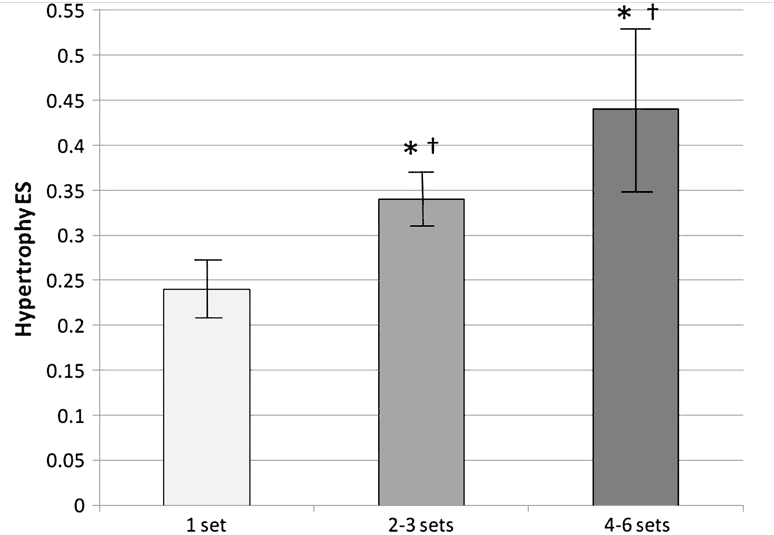
This 2010 meta-review showed that performing 1 set per muscle group per exercise, induced the smallest amount of hypertrophy.
Moreover, doing 2-3 sets also increased hypertrophy by around 42% more than doing 1 set. Finally, doing 4-6 sets further increased hypertrophy by around 30% more than doing 2-3 sets.
So the more sets the better right?
Not quite. And here’s why.
Findings suggest performing >5 sets per exercise does not promote greater gains in muscle strength and hypertrophy.
Hackett et al. 2018
Another 2018 study showed that performing anything more than 5 sets per muscle group per workout did not return any more added benefits.
In other words, anything above 5 sets becomes redundant (commonly called “wasted sets”).
The take-home message from these two studies is to stay within the optimal 2-5 set range.
And it just happens to be that 3-4 sets are right in the middle of this range!
You can also check out my other article to find out the ideal workout duration!
Why 3 Sets Are Enough For Hypertrophy.
Many beginners question if 3 sets are enough to build muscle. And here’s the answer:
In general, 3 sets per muscle group per workout is enough to build muscle. However, it is recommended to choose a rep-range and weight load that is conducive to hypertrophy. This is generally accepted to be around 15+ reps per set at 65% of maximal lifting capacity.
You can check out my other post for an example 3 x 15 workout with a focus on hypertrophy.
The effectiveness of working at 3 sets has been shown in this 2019 meta review.
Here, numerous studies have consistently shown that performing 3 sets is enough to build muscle.
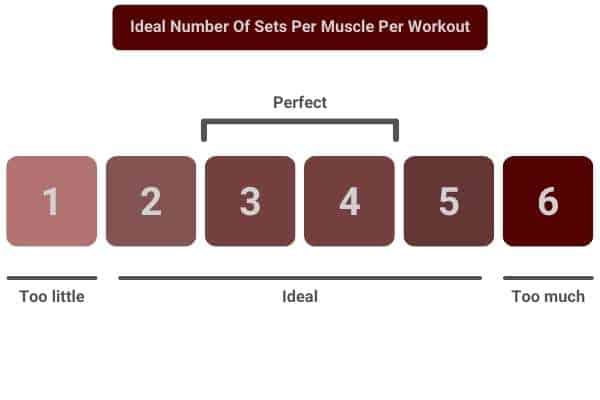
In fact, 3 sets lie right in the interquartile range for the ideal number of sets for hypertrophy.
And if you don’t know what that means….simply put- 3 sets are great for muscle growth!
However, you must make sure you’re lifting enough weight (at least 60% of your 1-rep max).
Note: 1 rep max is the maximum amount of weight you can lift for an exercise for 1 repetition.
How 4 Sets Can Also Be Ideal For Hypertrophy.
Beginners also often question if 4 sets are too much for optimal muscle building. And here’s the answer:
In general, 4 sets per muscle group per workout is not too much for optimal muscle-building. 4 sets are considered to be in the upper range for the ideal number of sets to build muscle. It is not recommended to exceed more than 5 sets.
This has been shown in a 2015 study.
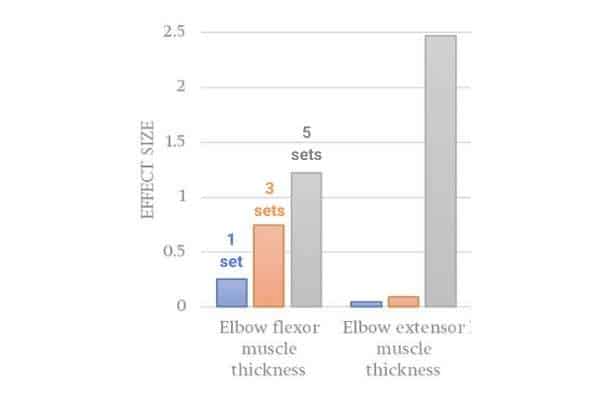
Here, the dose-response relationship was again shown, where more sets = more growth.
Additionally, 4 sets also lie in the interquartile range for the ideal number of sets for hypertrophy (just like with 3 sets)
Furthermore, 4 sets are also below the threshold for wasted sets (explained previously)
Take home message? 4 sets are not too much!
Take Home Message: Work Within 3 And 4 Sets.
As you can now see, 3 sets and 4 sets both lie in the sweet spot for hypertrophy.
So instead of comparing 3 vs 4 sets, and arguing about which is better, you should shift your mindset into realizing that both can be just as good as each other.
Both lie in the ideal range of sets which are neither too much (wasted sets) nor too little (not enough for hypertrophy).
So as long as you are working in the 3 to 4 set range, you’re generally in a good place!
That being said, it’s also important to reach 10-20 sets per muscle group per week. This is widely considered to be the ideal number of sets for hypertrophy. And you shouldn’t go over or under this target if you’re looking to put on muscle fast.
This is where it becomes important to choose between doing 3 or 4 sets (what I’ll explore next).
If you’re interested, you can go to my other article for a 50lb dumbbell workout that builds muscle using 4 sets!
Choosing The Optimal Number Of Sets.
Below, I’ll explain how you should choose whether to do 3 or 4 sets per workout for optimal muscle gains.
How Many Sets Should You Do Per Workout To Build Muscle?
First, let’s discuss how many sets you need to be doing per workout for optimal hypertrophy.
In general, it is recommended to complete 10-20 sets per muscle group per week.
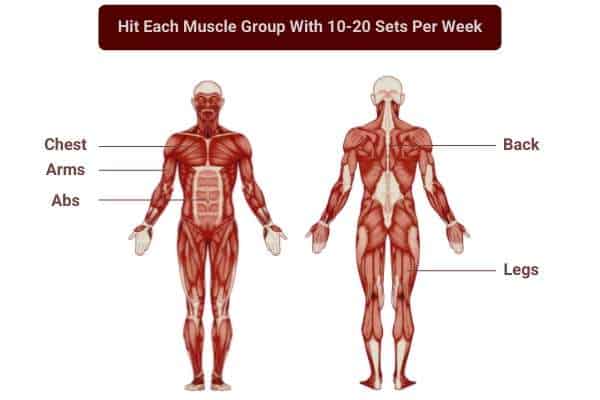
If you assume 6 major muscle groups (chest, shoulders, arms, back, abdominals, and legs), then that equates to 60 to 120 total weekly sets of compound exercises (or 10-20 sets for each muscle group).
Assuming you’re training with a 3 to 4-day full-body split, then 3 to 4 sets per muscle per workout are both enough to satisfy this weekly target.
For example, adopting a 3-day split doing 3-4 sets means you’re hitting each muscle with 9-12 sets per week. In my experience, this is great for beginners.
In contrast, adopting a 4-day split doing 3-4 sets \ means you’re hitting each muscle with 12-16 sets per week. This is more suited to intermediates.
Both of the above fall within the recommended number of total weekly sets for hypertrophy.
Additionally, it’s also important not to undershoot or exceed the recommended weekly number of sets.
If you perform less than 60 total sets, then you run the risk of not satisfying the training volume required for whole-body hypertrophy.
On the other hand, if you do more than 120 total sets, you risk overtraining and/or doing wasted sets. Neither of these is beneficial to grow muscle and can even be counterproductive.
With that being said, 60-120 sets is a wide range. So let’s narrow it down a bit more.
Are 3 Or 4 Sets Better?
Depending on who you are, your training frequency, and your goals, 3 and 4 sets can be just as effective and neither is inherently better than the other.
Therefore, the optimal number of sets will vary from person to person. And it’s heavily influenced by your current training level.
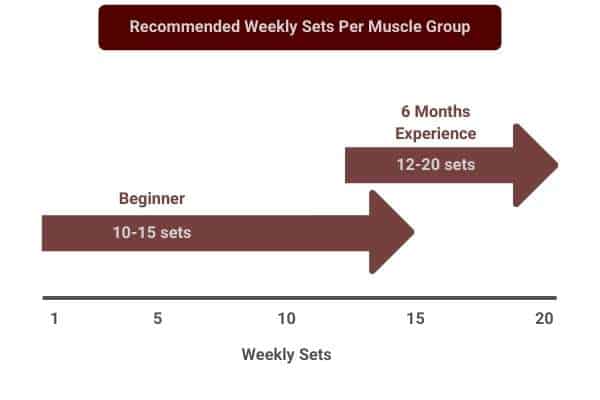
For beginners, I would recommend you complete 10-15 sets per muscle group per week. This can be achieved, for example, by doing 3 sets per muscle group for a total of 4 training days per week. Absolute beginners could even do 3 sets per muscle group for a total of 3 training days per week.
After 6 months of consistent training, you’re approaching the intermediate stage, and you can begin to increase to 12-20 sets per muscle group per week (should you wish). This can be achieved by doing 4 sets per muscle group for a total of 3-4 training days per week.
This way, you allow your muscles to adapt to the increasing workload. For a timeline of expected results, you can go to my other article for more info on how long it takes to get bigger muscles.
Allowing for adaptation is important because the difference between 10 sets per week and 20 sets per week is significant. And you want to increase your sets only as your muscles become stronger.
Put it this way- you wouldn’t run a full marathon before running a half marathon first right?
You may also be interested in my other article for more training and diet tips for skinny guys to build muscle!
Why Training Frequency Dictates How Many Sets You Should Do.
Your ultimate goal is to reach your target number of weekly sets per muscle (whether that be 10, 11, 12, 15, or whichever is suitable to your training level as described above).
Your training frequency (number of workouts each week) in turn affects how many sets you perform for each workout, as follows:
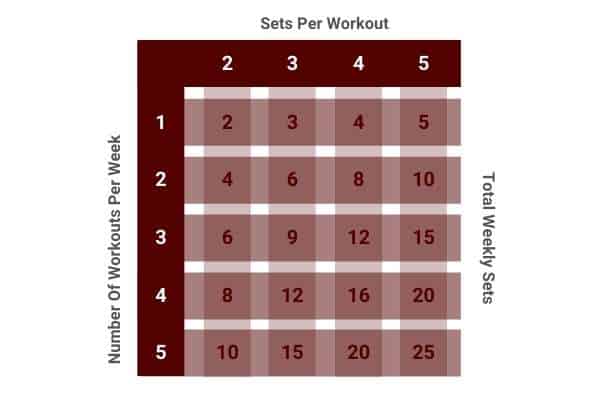
If you train a muscle more often, then you’ll want to perform fewer sets per workout.
The opposite is also true.
If you train a muscle less frequently, then you’ll want to do more sets per workout.
As an example- a beginner who wants to reach 12 sets per week for a given muscle could do:
- 3 sets per exercise per workout for 4 workouts.
Or…
- 4 sets per exercise per workout for 3 workouts.
Both would equate to 12 sets.
The name of the game is to optimize your sets around your training days to reach the ideal target weekly sets for your training level. This is called equating training volume.
You can check out my other article to find out the ideal number of training days!
Are 4 Sets Too Much?
Taking all this together, now you know how many sets become too much:
For the average person, 6 sets per muscle group per workout is too much. Additionally, performing 20 sets per muscle group per week is also too much. Exceeding these recommendations increases the likelihood of overtraining and wasted time on redundant sets.
Anything below 6 sets is generally Ok.
My general advice would be to stay within 3 to 4 sets per muscle group per workout. This is ideal for training in the 8-15 rep range (generally considered to be the best to build muscle size).
But if you really want to push towards 5 sets, then first start with 3 sets and work your way towards 5. It’s ok to complete 5 sets per workout. In fact, strength-focused workouts usually adopt higher sets for lower reps (e.g. 5 reps per set for 5 sets).
After you’ve reached a point where 5 sets per muscle group per workout becomes easy, you should begin increasing weight to keep your workouts challenging. But never exceed more than 5 sets per workout.
Next, I’ll explain how many reps you should be doing per set.
You can also check out my other article to learn how to tell if you’re lifting too much or too little weight.
Choosing The Right Number Of Reps.
The number of reps you perform (rep-range) should be goal-based. In other words, you should choose your reps based on your primary training goal:
| Training Goal | Sets | Reps | Rest Between Sets | Weight |
|---|---|---|---|---|
| Hypertrophy | 3 to 5 | 6 to 15 | 30 to 90 seconds | 70 to 80% of 1RM |
| Strength | 3 to 5 | 3 to 6 | 2 to 5 minutes | 80 to 90% of 1RM |
| Power | 3 to 5 | 1 to 2 | 2 to 5 minutes | 90 to 100% of 1RM |
| Endurance | 3 to 4 | 15+ | 30 to 60 seconds | 40 to 60% of 1RM |
Firstly, the classic rep-range for hypertrophy is 8-12 reps per set. But modern standards have begun to shift towards a much wider 6-15 reps.
Working in this rep-range will yield a balance of myofibrillar and sarcoplasmic hypertrophy. This means your muscles will become both stronger and bigger.
Secondly, you could also choose to work in a lower rep range of 3-6 reps. This is more conducive to myofibrillar hypertrophy and strength gains, but your muscles can also experience some sarcoplasmic hypertrophy.
Finally, your other option is to work in a higher 15+ rep range. This is mostly for endurance training. But it can also promote hypertrophy if you’re using sufficient weight to take each set to failure.
Don’t have a gym membership? You can check out my other article to learn how to build muscle at home!
The Best Rep-Range For Muscle Growth.
As I mentioned above, the ideal rep range for hypertrophy is 6-15 reps.
But this is quite a wide spectrum.
Let’s get a bit more specific.
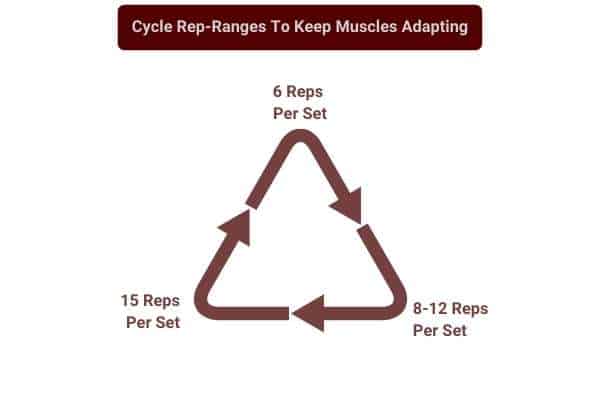
By far, the favorite hypertrophy rep-range for most people is 8-12 reps.
This rep-range offers a good balance between allowing you to:
- Shift heavy weights.
- Maintain time-under-tension (TUT).
- Achieve a high training volume.
Combined, these 3 parameters drive muscle growth.
However, this 2015 study also showed that low rep ranges of 3-5 reps per set can actually be better for hypertrophy, compared to 8-12 reps.
All in all, I would advise beginners to intermediates to focus on the 8-12 rep-range.
But you can also occasionally switch to lower rep ranges of ~6 reps per set or high rep ranges of 15+ reps per set. This way, you are constantly presenting the muscle with a new stimulus.
Additionally, rather than obsessing about your rep-range, you should instead concentrate on getting stronger. You can do this by progressively adding more weight to your lifts over time.
This is called progressive overload, and it’s the most important factor in driving sustained muscle growth!
If you’re new to training, you can check out my other article to find out which muscles are easiest to develop!
How Many Reps Are Too Many?
Taking all this together, now you know how many reps become too much:
In general, performing more than 15 reps per set is usually too much for hypertrophy. Additionally, it is recommended to perform no less than 25 total reps, and no more than 50 total reps, per muscle group per workout. Following these recommendations will ensure adherence to the hypertrophy range.
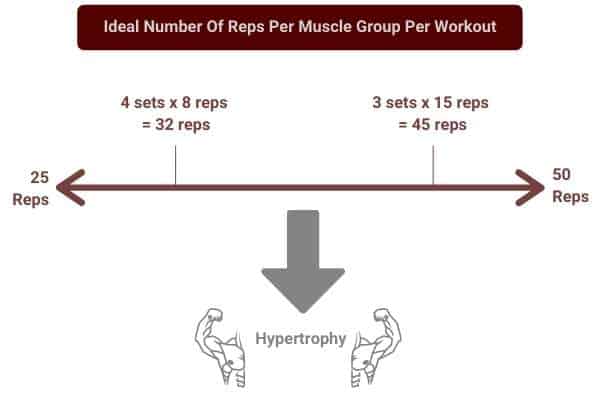
How you reach the ideal rep range is up to you.
For example, you could do 4 sets of 8 reps for a total of 32 reps.
Alternatively, you could also do 3 sets of 15 reps for a total of 45 reps.
Either way, you are still within the recommended range of 25 to 50 reps.
Again, as long as you are getting stronger with time, you’ll also be getting bigger!
Set-Rep Combinations And What They Are Good For.
Let’s recap the best training volume (sets and reps) to build muscle:
- 3-4 sets per muscle group per workout.
- 10-20 total sets per muscle group per week
- 6-15 reps per set.
- 25-50 total reps per workout.
If you stay within this range, and you are eating a caloric surplus with and high-protein intake (also called “bulking”), then you will get stronger and bigger (you can check out my other article to learn about the ideal bulking duration).
The most important thing is to work your muscle to full fatigue.
Doing this gives you the fundamental foundation to build muscle.
The minutia regarding the exact number of reps and sets is insignificant for beginners.
If you’re an advanced bodybuilder, then yes you will want to optimize as much as possible.
But for the average Joe, just worry about staying within the above ranges and challenging yourself with sufficient weight.
If you’re keen to optimize your training, here’s how each rep-range can help you reach your goals:
| Sets | Reps | Good For: |
|---|---|---|
| 3 | 5 to 6 | Myofibrillar Hypertrophy |
| 3 | 7 to 12 | Myofibrillar and Sarcoplasmic Hypertrophy. |
| 3 | 13 to 15 | Sarcoplasmic Hypertrophy |
| 3 | 15+ | Endurance |
| 4 | 5 to 6 | Myofibrillar Hypertrophy |
| 4 | 7 to 12 | Myofibrillar and Sarcoplasmic Hypertrophy. |
| 4 | 13 to 15 | Sarcoplasmic Hypertrophy |
| 4 | 15+ | Endurance |
3 to 4 Sets of 5 to 6 Reps.
Doing 3 to 4 sets of 5 to 6 reps is ideal for myofibrillar hypertrophy to build muscle and strength (with an emphasis on strength), through 2 mechanisms:
- Direct myofibrillar hypertrophy- as your muscle fibers grow larger, your muscles will gain strength and grow bigger.
- Overcoming strength plateaus- low rep ranges are ideal for applying progressive overload and this allows you to lift heavier weights and induce more myofibrillar hypertrophy to grow bigger.
This approach is best used for large compound exercises such as the bench, squat, deadlift, row, and overhead press (including their variations).
These exercises engage the largest muscles in your body and thus allow you to capitalize on strength gains.
Beginners can do strength training at home by buying an affordable setup from Amazon.
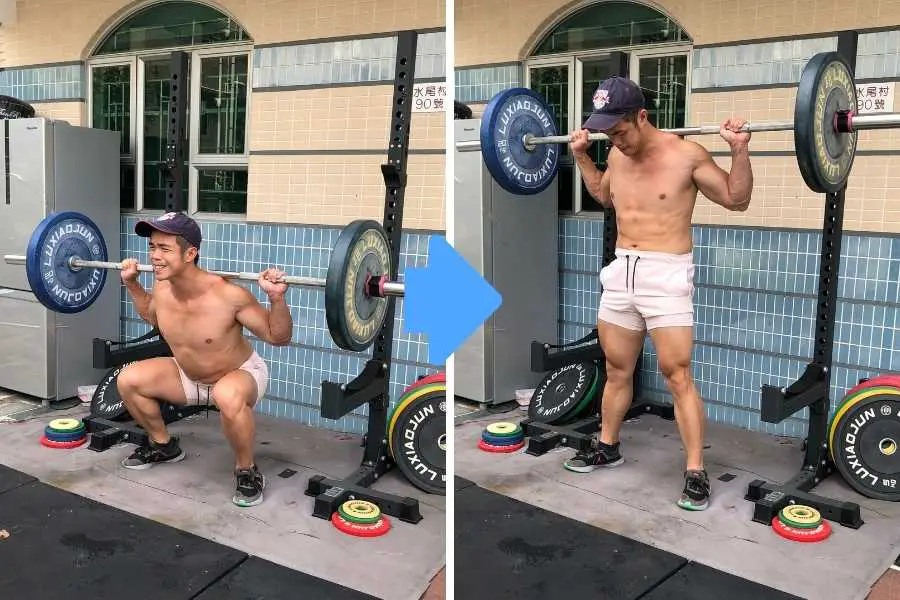
I’ve tested this CAP Olympic barbell and it’s very durable. It goes well with the Balance From cast iron plates, Bang Tong rack.
3 to 4 Sets of 7 to 12 Reps.
Doing 3 to 4 sets of 7 to 12 reps strikes a good balance between myofibrillar and sarcoplasmic hypertrophy.
As such, this is the recommended rep-range for the majority of people to lift in for the majority of the time.
That being said, bear in mind that your muscles don’t know how many reps you’re giving them. They only react to the stimulus.
Therefore it’s recommended to vary your program regularly to challenge the muscles in different ways.
This commonly involves alternating between low and high reps with heavy and light reps.
Both forms of training offer a different kind of hypertrophy stimulus.
Heavier weights provide a greater mechanical tension, whereas lighter weights provide a longer time-under-tension. Both stimuli are drivers of muscle growth.
Adjustable dumbbells work great for this style of varied training.
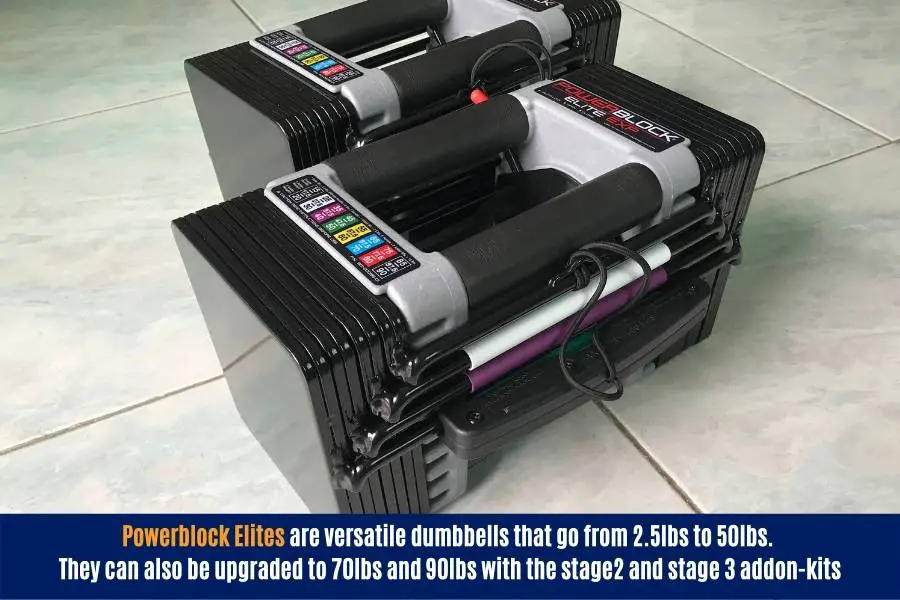
I currently use and recommend the Powerblock Elites. They’re fully adjustable. They start at 2.5lbs per dumbbell and go all the way up to 90lbs per dumbbell (with the addon kits which are purchased separately)
The lighter settings are perfect for doing 12 reps of isolation lifts like the bicep curl, whilst the heavier settings are great for low-rep heavy compound lifts like the bench press.
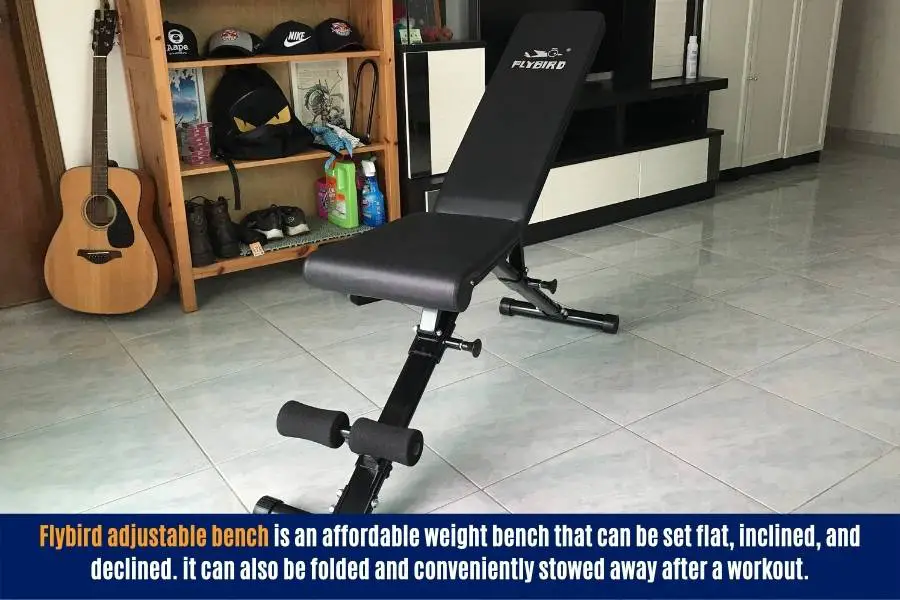
You’ll need a bench to do the bench press.
I use the Flybird adjustable bench.
It’s cheap, has a weight capacity of 700lbs, and can also be folded after your workout.
You can see my full review here.
3 to 4 Sets of 13 to 15 Reps.
Doing 3 to 4 sets of 13 to 15 reps is ideal to promote sarcoplasmic hypertrophy.
Since there’s an inverse rep-weight relationship (higher reps = lower weight), this kind of training allows you to put the muscle under a longer duration of tension.
This is a great way to shock your muscle and force it to adapt.
Additionally, the sarcoplasm is responsible for providing your muscle fibers with energy. And this makes high-rep training beneficial for improving your muscular endurance whilst also promoting hypertrophy at the same time.
This approach is most beneficial for smaller isolation exercises such as the bicep curl (check out my other post to find out the ideal sets and reps to grow biceps), flyes, lateral raise, and tricep extensions.
Isolation exercises target smaller muscle groups, and these often require lower weights to achieve maximal contraction.
You can do this type of training with the Powerblock Elites. The Elites can also be used to do heavy lifting in the 3 to 4 set and 7 to 12 rep range.
3 to 4 Sets of 15+ Reps.
Doing 3 to 4 sets of 15+ reps is mostly good for lighter weights and endurance training.
As such, you should generally avoid doing anything over 15 reps per set if your main goal is to build muscle and strength.
However, there’s an exception.
Some bodybuilders and powerlifters advocate doing 15+ reps per set with heavy weights.
In this manner, you would push your muscle to failure and use rest-pauses where necessary.
Rest-pauses involve stopping at the point of failure, taking a few seconds to rest, then powering through to your desired rep-count.
This essentially turns your set into a series of mini-sets.
If you’re feeling adventurous, you can give this a go. These types of workouts usually involve lifting low sets (e.g. 2 sets per exercise), which can save you a lot of time.
Just a note- this type of workout is usually very challenging (it will push you to failure) and generally unnecessary for most people. I recommend most beginners stick to the above rep-ranges instead!
The Combination Approach.
As I mentioned above, your muscles only react to stimuli. It doesn’t know how many reps and sets you are making it perform.
Furthermore, it’s good to present the muscle with different stimuli to keep them second-guessing.
This forces your muscles to adapt each time. And this drives growth.
The best way to do this is through a combination approach.
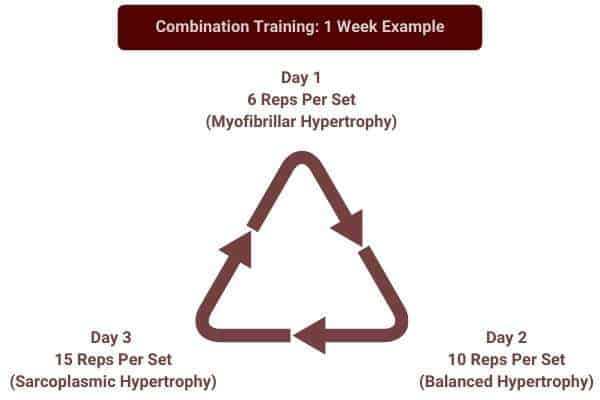
This can be done in numerous ways.
For example, you could hit each muscle group with 3 workouts per week.
But on each workout, you’ll perform different rep ranges:
- First workout- 3 sets of 6 reps at 85% of 1RM.
- Second workout- 4 sets of 10 reps at 75% of 1RM.
- Third workout- 4 sets of 15 reps at 60% of 1RM.
By mixing up your training in this way, you will get the best of all worlds- strength, size, and endurance!
The easiest way to do this at home is to either get a barbell like the CAP Olympic barbell with a selection of weight plates or use a fully adjustable dumbbell like the Powerblock Elite.
Choosing The Right Weight.
Doing different rep-ranges all the time can become confusing.
You’ll need to adjust your weight for each rep-range.
To make your life easier, you can follow my strength curve:
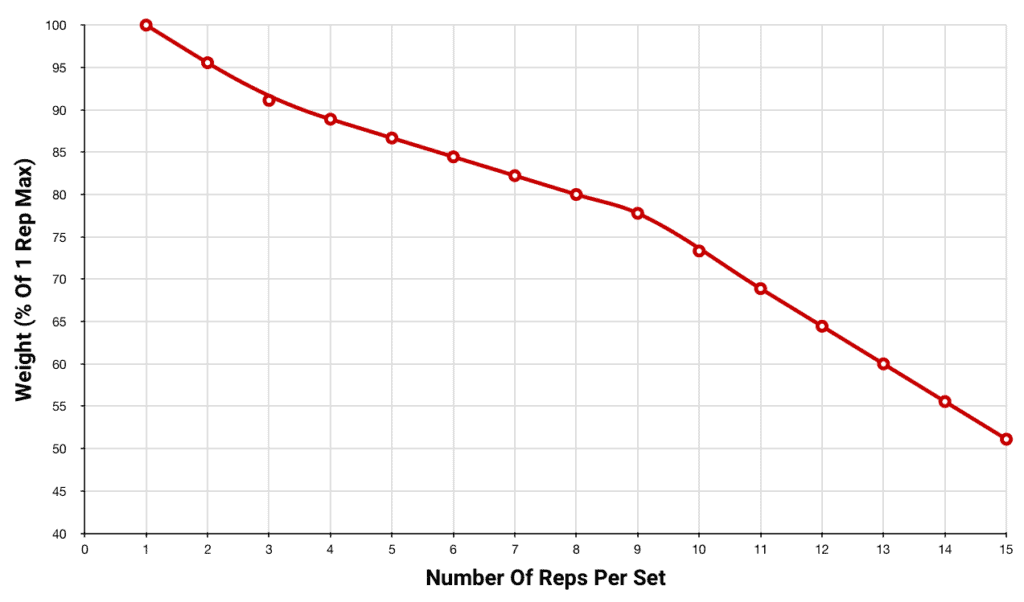
It’s a visual representation of Bill Geiger’s rep-weight relationship.
To determine how much weight you should be lifting, simply identify your rep-range and the line will establish your recommended weight as a % of your 1RM.
If you don’t know your 1RM, then no worries.
You can use Strength Level’s strength standards to estimate your 1RM for each exercise.
If you plan on using dumbbells to build muscle, you may be interested in my other article to find out the ideal dumbbell weight to gain muscle.
Conclusion
Today I’ve discussed whether 3 or 4 sets are better to build muscle.
Both are equally well-suited for promoting hypertrophy.
Whether you decide to go with 3 sets or 4 sets will largely be influenced by the number of workouts you schedule for the muscle.
If a muscle is worked more frequently during the week, then it makes sense to do 3 sets per workout.
Conversely, if you work a muscle less frequently, then it makes sense to do 4 sets per workout.
The more important point to make is to optimize your overall training volume (reps, sets, and weight).
You should aim to work each muscle with 10-20 sets per week, and do no more than 15 reps per set, at intensities of 60-90% of your 1 rep max.
How you reach this weekly training volume is flexible and entirely up to you!
You may also be interested in the downloadable Kalibre Blueprint PDF which details exactly how I gained 40lbs of lean muscle (it’s 100% free!). It details the exact exercises and nutrition (with printables) I used to go from skinny to ripped!



